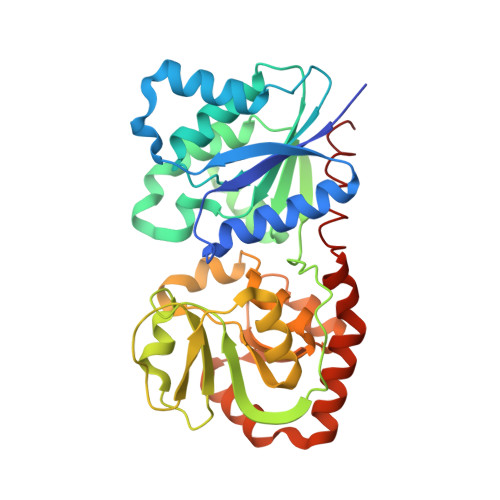Structural and Functional Analysis of a New Subfamily of Glycosyltransferases Required for Glycosylation of Serine-rich Streptococcal Adhesins.
Zhu, F., Erlandsen, H., Ding, L., Li, J., Huang, Y., Zhou, M., Liang, X., Ma, J., Wu, H.(2011) J Biological Chem 286: 27048-27057
- PubMed: 21653318
- DOI: https://doi.org/10.1074/jbc.M110.208629
- Primary Citation of Related Structures:
3QKW, 3RHZ - PubMed Abstract:
Serine-rich repeat glycoproteins (SRRPs) are a growing family of bacterial adhesins found in many streptococci and staphylococci; they play important roles in bacterial biofilm formation and pathogenesis. Glycosylation of this family of adhesins is essential for their biogenesis. A glucosyltransferase (Gtf3) catalyzes the second step of glycosylation of a SRRP (Fap1) from an oral streptococcus, Streptococcus parasanguinis. Although Gtf3 homologs are highly conserved in SRRP-containing streptococci, they share minimal homology with functionally known glycosyltransferases. We report here the 2.3 Å crystal structure of Gtf3. The structural analysis indicates that Gtf3 forms a tetramer and shares significant structural homology with glycosyltransferases from GT4, GT5, and GT20 subfamilies. Combining crystal structural analysis with site-directed mutagenesis and in vitro glycosyltransferase assays, we identified residues that are required for UDP- or UDP-glucose binding and for oligomerization of Gtf3 and determined their contribution to the enzymatic activity of Gtf3. Further in vivo studies revealed that the critical amino acid residues identified by the structural analysis are crucial for Fap1 glycosylation in S. parasanguinis in vivo. Moreover, Gtf3 homologs from other streptococci were able to rescue the gtf3 knock-out mutant of S. parasanguinis in vivo and catalyze the sugar transfer to the modified SRRP substrate in vitro, demonstrating the importance and conservation of the Gtf3 homologs in glycosylation of SRRPs. As the Gtf3 homologs only exist in SRRP-containing streptococci, we conclude that the Gtf3 homologs represent a unique subfamily of glycosyltransferases.
- Department of Pediatric Dentistry and Microbiology, University of Alabama at Birmingham, Schools of Dentistry and Medicine, Birmingham, Alabama 35294, USA.
Organizational Affiliation:


















